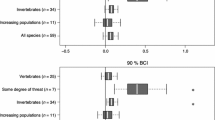Abstract
We examined the population dynamics of small mammals in an experimentally fragmented, successional field over three years. Patches of three sizes (32 m2, 288 m2, and 5000 m2) were censused at biweekly intervals, and data for the three common species were grouped by patch size and analyzed for relative population density, persistence of individuals, and patterns of movement among patches. The three species sorted by patch size, with the largest (Sigmodon hispidus) most abundant on the largest patches, the smallest (Peromyscus maniculatus) most abundant on the smallest patches, and the intermediate-sized (Microtus ochrogaster) most abundant on medium patches. Our explanation for this spatial pattern in density involves the interplay of source-sink dynamics and interspecific interactions. Persistence times for the two larger species were highest on large patches, but P. maniculatus persisted equally well on all patch sizes. Eighty-five percent of individual moves for all species occurred within a patch size. Individuals that dispersed between patch sizes tended to move towards a larger size patch. Our results suggest that in the future, metapopulation theory and analyses of habitat fragmentation should consider in more detail the effects of intra- and interspecific density-dependent interactions.
Access this chapter
Tax calculation will be finalised at checkout
Purchases are for personal use only
Preview
Unable to display preview. Download preview PDF.
Similar content being viewed by others
Literature Cited
Bazzaz, F. A. 1968. Succession on abandoned fields in the Shawnee Hills, southern Illinois. Ecology 49: 924–936.
Collins, S. L., and D. E. Adams. 1983. Succession in grasslands: thirty-two years of change in a central Oklahoma tallgrass prairie. Vegetation 51: 181–190.
Doak, D. 1989. Spotted owls and old growth logging in the Pacific Northwest. Conservation Biology 3: 389–396.
Ehrlich, P. R., and D. D. Murphy. 1987. Conservation lessons from long-term studies of checkerspot butterflies. Conservation Biology 2: 122–131.
Fleharty, E. D., and L. E. Olson. 1969. Summer food habitats of Microtus ochrogaster and Sigmodon hispidus. Journal of Mammalogy 50: 475–486.
Foster, J., and M. S. Gaines.1991. The effects of a successional habitat mosaic on a small mammal community. Ecology 72: 1358–1373.
Frydenhall, M. J. 1969. Rodent populations on four habitats in central Kansas. Transactions of the Kansas Academy of Sciences 72: 213–222.
Glass, G. F., and N. A. Slade. 1980. Population structure as a predictor of spatial association between Sigmodon hispidus and Microtus ochrogaster. Journal of Mammalogy 61: 473–485.
Hanski, I., and M. Gilpin. 1991. Metapopulation dynamics: brief history and conceptual domain. Biological Journal of the Linnean Society 42: 3–16.
Holt, R. D. 1985. Population dynamics in two-patch environments: some anomalous consequences of an optimal habitat distribution. Theoretical Population Biology 28: 181–208.
Holt, R. D., G. R. Robinson, and M. S. Gaines. 1991. Vascular plant diversity and succession in experimental habitat fragments. Manuscript.
Ims, R. A. 1990. The effect of habitat fragmentation on social systems: small rodents as an empirical model system. Abstract, V International Congress of Ecology meetings.
Johnson, M. L., and M. S. Gaines. 1987. The selective basis for dispersal of the prairie vole, Microtus ochrogaster. Ecology 68: 684–694.
Kadmon, R., and A. Shmida. 1990. Spatiotemporal demographic process in plant populations: an approach and a case study. American Naturalist 135: 382–397.
Keddy, P. A. 1981. Experimental demography of the sand-dune annual, Cakile edentula, growing along an environmental gradient in Nova Scotia. Journal of Ecology 69: 615–630.
Lande, R. 1988. Demographic models of the northern spotted owl (Strix occidentals caurina). Oecologia 75: 601–607.
Levins, R. A. 1980. Extinction. American Mathematical Society 2: 77–107.
Mackelberg, L. E., and J. G. Hallet1991. Effects of habitat patchiness on spatial distribution and social organization of Microtus montanus. Abstract, American Society of Mammalogists, 71st annual meeting.
Pulliam, H. R. 1988. Sources, sinks and population regulation. American Naturalist 110: 107–119.
Stenseth, N. C. 1990. Habitat fragmentation: reflections on landscape ecological studies on model organisms. Abstract, V International Congress of Ecology meetings.
Terman, M. R. 1974. Behavioral interactions between Microtus and Sigmodon: a model for competitive exclusion. Journal of Mammalogy 55: 705–719.
Author information
Authors and Affiliations
Editor information
Editors and Affiliations
Rights and permissions
Copyright information
© 1992 Elsevier Science Publishers Ltd
About this chapter
Cite this chapter
Gaines, M.S., Robinson, G.R., Diffendorfer, J.E., Holt, R.D., Johnson, M.L. (1992). The Effects of Habitat Fragmentation on Small Mammal Populations. In: McCullough, D.R., Barrett, R.H. (eds) Wildlife 2001: Populations. Springer, Dordrecht. https://doi.org/10.1007/978-94-011-2868-1_66
Download citation
DOI: https://doi.org/10.1007/978-94-011-2868-1_66
Publisher Name: Springer, Dordrecht
Print ISBN: 978-1-85166-876-2
Online ISBN: 978-94-011-2868-1
eBook Packages: Springer Book Archive




